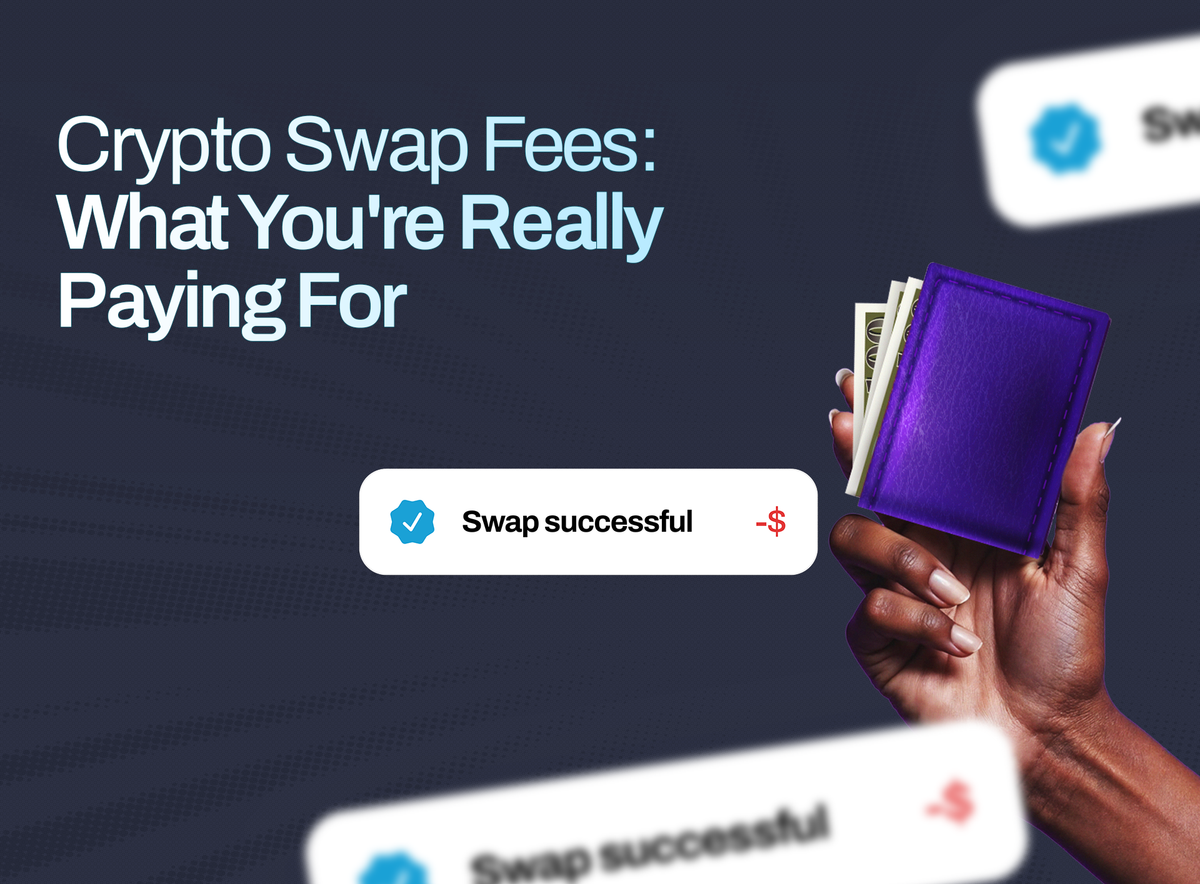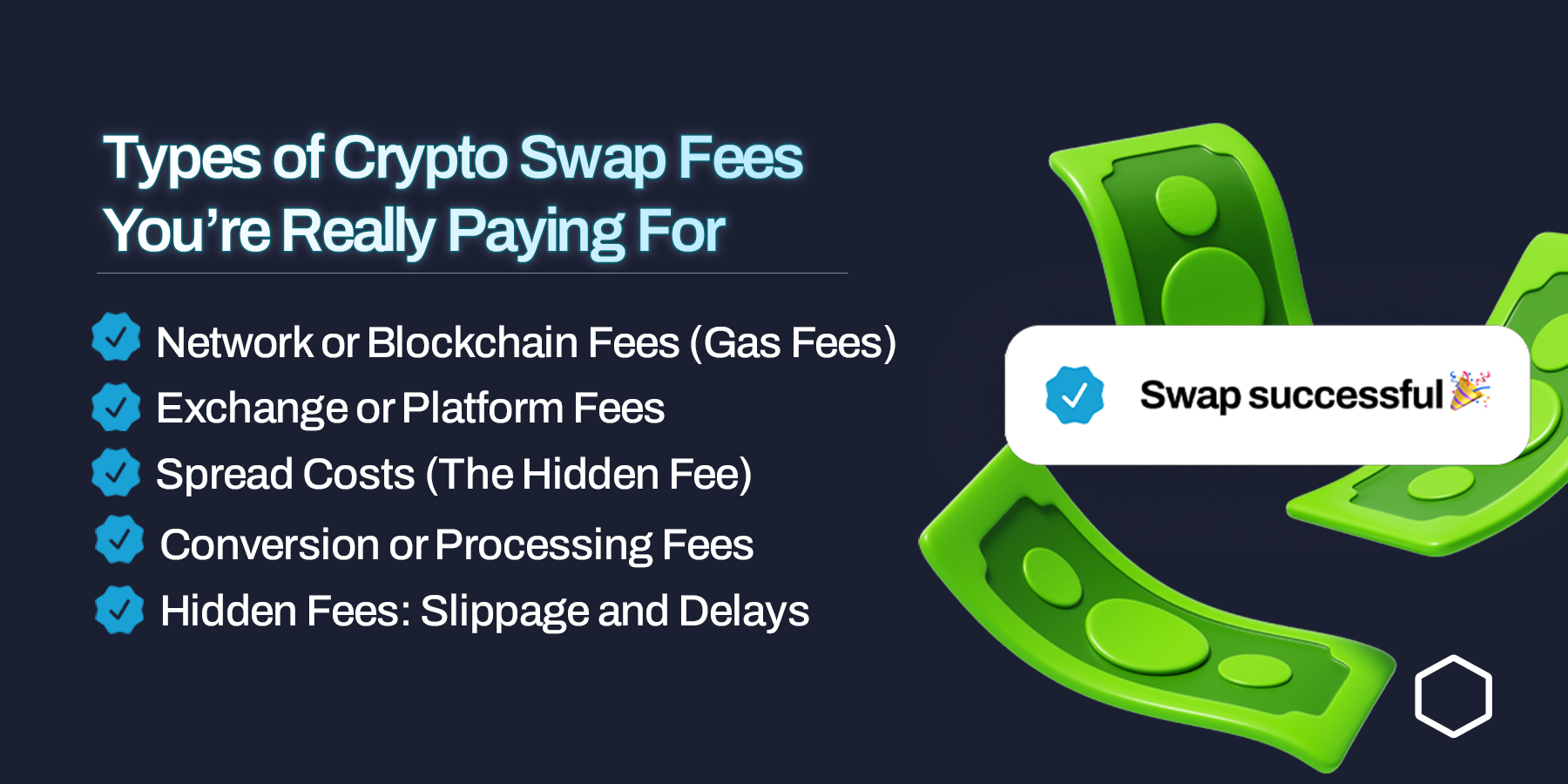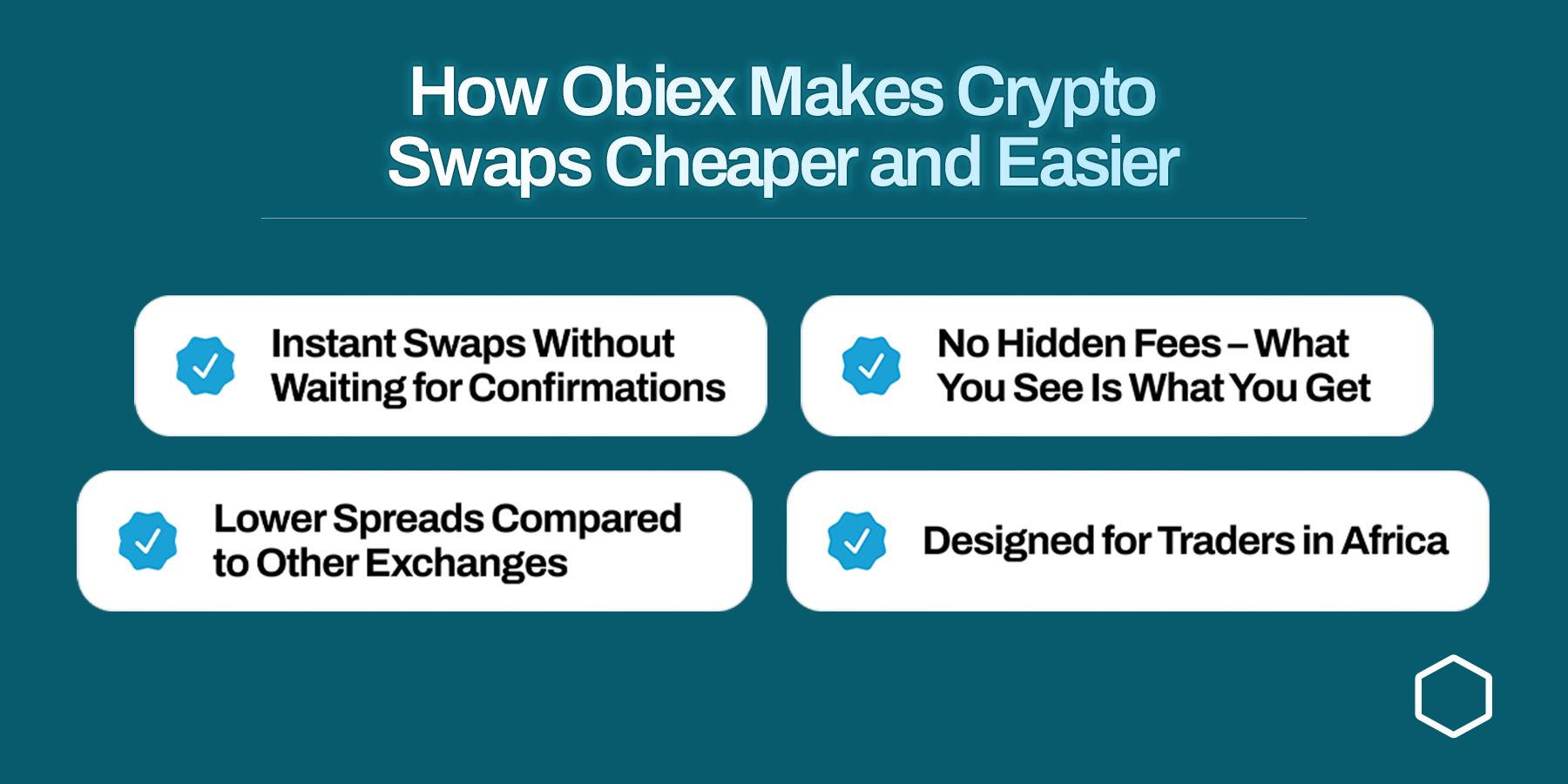Crypto Swap Fees: What You’re Really Paying For
Learn what crypto swap fees are, why they matter, and what you’re really paying for. Discover how Obiex’s swap without confirmation feature helps you save money and trade faster.

Table of Contents
- Types of Crypto Swap Fees You’re Really Paying For
- Why Swap Fees Matter More Than You Think
- How Obiex Makes Crypto Swaps Cheaper and Easier
- The Hidden Cost of Delayed Confirmations (and How Obiex Solves It)
- Who Benefits Most From Lower Swap Fees?
- Practical Tips to Reduce Crypto Swap Fees (Beyond Obiex)
- To Recap
- FAQs
Every time you swap crypto, you’re paying more than you think.
Most traders assume the only cost of swapping is the price difference between two coins.
But in reality, there are multiple hidden costs built into every crypto swap.
So, let’s break down what you’re really paying for when you make a crypto swap.
Types of Crypto Swap Fees You’re Really Paying For
When you swap crypto, you don’t just pay one flat fee. The total cost is usually made up of different types of charges, some clear and some hidden. Let’s break them down:
1. Network or Blockchain Fees (Gas Fees):
This is the money you pay directly to the blockchain to process your transaction. On Ethereum, it’s called a gas fee. On Bitcoin, it’s just a network fee.
- These fees go to miners or validators who confirm and secure your swap.
- They change depending on the blockchain's activity.
- Example: On Ethereum, gas fees can be as low as $1–$2 during quiet hours but can shoot up to $50 or more when the network is congested.
2. Exchange or Platform Fees:
Every platform that allows you to swap crypto takes a small cut. This is how exchanges make money.
- It’s usually a percentage of the swap amount.
- Most platforms charge between 0.1% to 1% per swap.
- For example: if you’re swapping $1,000 worth of ETH for USDT on a platform that charges 0.5%, you’ll instantly lose $5 to platform fees.
3. Spread Costs (The Hidden Fee):
This one is the most overlooked in crypto swaps.
The spread is the difference between the highest price a buyer is willing to pay (the bid price) and the lowest price a seller is willing to accept (the ask price) for a coin.
Because exchanges act as the middleman, they usually set the swap rate somewhere between these two prices. That difference (the spread) is a hidden fee that reduces the amount of crypto you actually receive.
Example: If Bitcoin’s bid price is $117,000 and the ask price is $117,200, the spread is $200. If your platform makes you swap at the higher price, you’re paying more than the market’s best rate without realising it.
Unlike platform fees, spreads are not always clearly displayed. They are built into the swap rate itself, which makes them harder for traders to spot.
4. Conversion or Processing Fees:
Some exchanges add extra charges if you’re swapping between certain types of coins, especially stablecoins like USDT, USDC, or BUSD.
- For example, a platform might quietly charge an extra 0.1%–0.2% to process a stablecoin-to-stablecoin swap.
- These fees don’t look big at first, but if you’re doing frequent trades, they accumulate quickly.
5. Hidden Fees: Slippage and Delays:
These are the fees you don’t see coming but feel in your pocket.
- Slippage happens when the price changes between the time you start a swap and when it finishes. For example, you try to swap ETH at $2,800, but by the time it confirms, the price is $2,790. You just lost $10 without realising it.
- Confirmation delays also cause hidden costs. On most platforms, you have to wait for blockchain confirmation before your swap is final. In that waiting time (sometimes 5–15 minutes), the price can move against you.

Practical Breakdown Example (Swapping $500 of ETH to USDT):
- Network Fee: $5
- Platform Fee (0.5%): $2.50
- Spread Cost: $3
- Total Lost to Fees: $10.50
- Final Amount Received: $489.50 instead of $500
This example shows that even a “simple” swap can cost you more than you expect. Now imagine repeating that 10–20 times in a month. The hidden costs pile up.
Why Swap Fees Matter More Than You Think
1. Small Fees Add Up Quickly:
- If you swap $100 every day, and lose just $2 each time, that’s $60 gone in one month. Over a year, that’s $720 lost—the price of a decent Samsung Galaxy or iPhone.
- If you swap $1,000 once a week and pay around $10 in fees, that’s $40 a month or $480 a year.
Bottom line: Even “tiny” fees become hundreds of dollars over time.
2. They Impact Small Traders the Most:
For large traders, losing $10 on a $10,000 swap might not feel painful. But for someone swapping just $100, losing $3 is a 3% hit. That’s huge.
The smaller your swap, the bigger the percentage of your money that gets eaten by fees.
3. Frequent Traders Lose More Without Realising:
People who swap often, like dollar-cost averaging (DCA) buyers, day traders, or cross-border senders, lose more money to fees because of repetition. The more you swap, the more these charges pile up.
4. Hidden Fees Make It Worse:
The frustrating part is that many platforms don’t show you the full picture. You’ll see the network fee and maybe the platform fee, but spreads, slippage, and price changes during confirmations are often hidden. This lack of transparency makes it harder to know how much you’re really losing.
5. Fees Can Cancel Out Your Gains:
Imagine you swap into a coin that goes up by 5% in a week. If you lost 2–3% of your money in swap fees along the way, your real gain is cut almost in half. Over time, fees can literally cancel out your profits, leaving you frustrated.
The bottom line is that swap fees aren’t just small change. They directly affect how much money you keep from your trades. That’s why it’s important to use platforms that are transparent, affordable, and designed to minimise hidden costs.
How Obiex Makes Crypto Swaps Cheaper and Easier
1. Instant Swaps Without Waiting for Confirmations:
On many platforms, you start a swap but have to wait for the blockchain to confirm it. In that waiting time, prices can change (slippage), and you lose value.
Obiex removes that headache with its Swap Without Confirmation feature. This means your swap happens instantly, at the price you see, without waiting for blockchain approvals. No delays, no unexpected price swings.
2. No Hidden Fees – What You See Is What You Get:
With Obiex, there are no sneaky spreads or unannounced processing fees. You see the rate upfront, and that’s what you get. This level of transparency helps you plan your swaps better and avoid unpleasant surprises.
3. Lower Spreads Compared to Other Exchanges:
Spreads are one of the biggest “silent killers” of profit. Obiex works to keep spreads lower than many other platforms, so you get more crypto in your wallet after every swap.
4. Designed for Traders in Africa:
Obiex isn’t just another global exchange copy-paste. It was built with African crypto traders in mind. People who swap frequently, send money across borders, or need to move between stablecoins quickly. The platform is practical, easy to use, and tailored for everyday crypto needs.

The Hidden Cost of Delayed Confirmations (and How Obiex Solves It)
Why Do Confirmations Cause a Problem?
When you swap crypto on most exchanges, the transaction has to be confirmed by the blockchain before it is final.
This can take anywhere from a few minutes to 15 minutes or more, depending on the network and how busy it is.
The problem is that crypto prices move fast. Even a 5-minute wait is enough for the market to shift, meaning you may end up receiving less than you expected.
Example:
- You start swapping 0.5 ETH at a price of $2,800.
- While waiting for confirmation, the price drops to $2,790.
- By the time the swap is finalised, you’ve lost $10. Not because of platform fees, but simply because of the delay.
As I have already mentioned, this loss is known as slippage, and it’s one of the hidden costs traders rarely calculate.
The Real Impact of Slippage Over Time
On a single swap, losing $5–$10 might not feel huge. But if you swap often, the numbers add up quickly than you expect:
- Daily swaps with an average $5 slippage = $150 lost per month.
- Weekly swaps with an average $10 slippage = $520 lost per year.
That’s money gone simply because of waiting for confirmations.
How Obiex Solves This Problem
Obiex removes this risk with its Swap Without Confirmation feature. Here’s how it works:
- The moment you press swap, the transaction is completed instantly.
- You get the exact rate you see on the screen, without waiting for the blockchain to confirm it.
- No price changes, no slippage, no surprises.
This feature is especially useful during times of high volatility, when crypto prices can swing up or down by several dollars in just a few minutes. With Obiex, you lock in your price immediately.
Who Benefits Most From Lower Swap Fees?
1. Frequent Traders:
If you swap coins regularly, whether you’re buying dips, chasing trends, or moving funds around, fees can quickly pile up.
- Example: A trader making 10 swaps a week, losing an average of $3 per swap, wastes $30 weekly or $120 monthly just on fees.
- For active traders, even a small drop in swap fees translates into bigger savings.
2. Cross-Border Senders:
In many parts of Africa, crypto is used as a cheaper and faster way to send money across borders. But high swap fees can eat into the money you’re trying to send.
- For example, sending $200 and losing $5 in swap fees means the recipient gets less.
- Lower fees mean more value reaches friends, family, or business partners on the other side.
3. Dollar-Cost Averaging (DCA) Buyers:
DCA is when you buy crypto in small amounts regularly, instead of making one big purchase. It’s a popular strategy, but swap fees can quietly burn into returns.
- For example, buying $50 of Bitcoin every week, and losing just $1.50 to fees each time equals $78 lost in a year.
- Lower fees make DCA more effective, especially for smaller buyers.
4. Stablecoin Swappers:
Many people swap into stablecoins like USDT or USDC to protect against volatility or to cash out. The problem is that platforms often sneak in hidden spreads or conversion fees on stablecoin swaps.
- With lower fees, you get closer to the full value of your money, whether you’re securing profits or holding steady during market swings.
Practical Tips to Reduce Crypto Swap Fees (Beyond Obiex)
Even though Obiex gives you some of the lowest and most transparent swap fees, it’s still useful to know how to reduce costs no matter which platform you’re using. Here are some practical tips every trader can apply:
1. Swap During Low Network Congestion:
Blockchain fees (like Ethereum gas fees) go up when the network is busy. If you try swapping during peak hours, you’ll pay more.
- Pro tip: Gas fees are often cheaper late at night or during weekends. By timing your swaps wisely, you can sometimes cut fees in half.
2. Use Stablecoins Strategically:
Stablecoins like USDT, USDC, and BUSD usually come with lower fees compared to volatile coins like Bitcoin or Ethereum.
- If you often move funds between wallets or exchanges, convert to stablecoins first. This reduces both network and platform charges.
3. Compare Exchange Spreads Before Swapping:
Before swapping, check the actual rate you’re getting compared to the market rate.
- For example, if BTC is trading at $117,000, but your exchange only allows you to swap at $117,300, that $300 difference is your hidden spread.
- Always choose platforms that keep spreads small and transparent.
4. Avoid Too Many Small Swaps:
It might feel convenient to swap small amounts frequently, but fees stack up fast.
- Swapping $50 ten times with a $1.50 fee each = $15 lost.
- Swapping $500 once with a $5 fee = only $5 lost.
- Tip: If possible, combine smaller swaps into larger ones to save money.
5. Consider Layer-2 Networks (For Advanced Users):
Some blockchains, like Ethereum, are known for high gas fees. Using Layer-2 solutions (like Arbitrum or Optimism) or alternative blockchains (like Tron or BNB Chain) can reduce network costs.
- This tip is for more experienced users, but it’s worth exploring if you’re comfortable with different chains.
To Recap
- Swap fees are the hidden costs you pay every time you exchange one crypto for another.
- They come in different forms: network fees, exchange spreads, and platform charges.
- High fees eat into profits, especially for frequent traders, cross-border senders, and DCA buyers.
- Delayed confirmations can add extra, often unnoticed, costs.
- Obiex reduces these costs with instant swaps, low spreads, and transparent pricing.
- You can also cut fees by swapping at low-traffic times, using stablecoins, avoiding too many small swaps, and comparing spreads.
Stop overpaying hidden swap fees. Try Obiex today and enjoy instant, no-confirmation crypto swaps at the best rates.
👉 Download the Obiex app and start swapping smarter.
FAQs
Q1. What are crypto swap fees?
Crypto swap fees are the costs you pay when exchanging one crypto for another, including network fees, exchange cuts, spreads, and hidden charges.
Q2. Why are crypto swap fees so high sometimes?
They rise due to blockchain congestion (gas fees), platform charges, and volatile market conditions.
Q3. How do exchange spreads work?
Spreads are the difference between the buy and sell prices of a coin. It’s a hidden cost many traders overlook.
Q4. Do all exchanges charge the same swap fees?
No. Some exchanges are transparent, while others add hidden spreads and conversion charges.
Q5. How much can I lose to swap fees in a year?
Frequent traders can lose anywhere from $500–$1,000 annually in hidden swap fees if they don’t optimise.
Q6. What makes Obiex different from other exchanges?
Obiex offers instant swaps without confirmations, transparent fees, and lower spreads.
Q7. What is “Swap Without Confirmation” on Obiex?
It’s a feature that lets you execute swaps instantly at the rate you see, avoiding slippage and delays.
Q8. Who should use Obiex swaps?
Anyone who swaps crypto regularly, sends money across borders, or trades stablecoins.
Q9. How do I reduce swap fees if I’m not using Obiex?
Use off-peak hours, stablecoins, and fewer but larger swaps.
Q10. Is Obiex safe for swapping crypto?
Yes. Obiex is trusted by thousands of users in Africa and designed to provide fast, secure, and transparent swaps.
Disclaimer: This article was written to provide guidance and understanding. It is not an exhaustive article and should not be taken as financial advice. Obiex will not be held liable for your investment decisions.
